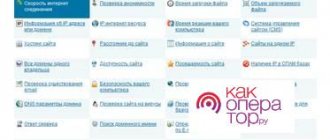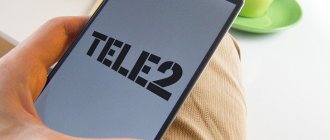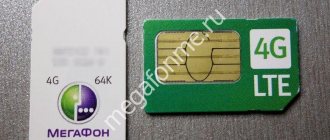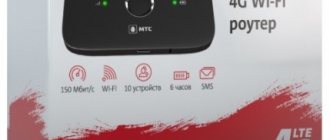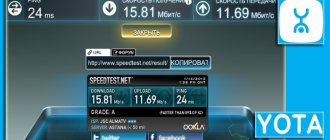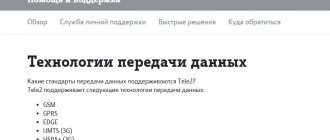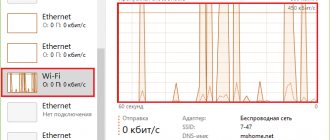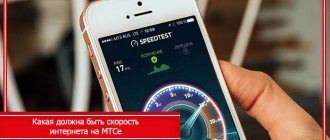What mobile Internet speed is considered normal? At first glance, this is a rhetorical question. After all, most users are sure that the higher the speed, the better. This prejudice is only partly true. In fact, not all users need ultra-high Internet connection speeds. In most cases, by declaring high speeds, the provider increases its own status and conversion, while access to the network is provided in standard mode. Let's try to figure out what the mobile Internet speed actually should be.
In what units is Internet speed measured?
Internet connection speed refers to the volume of data packet that passes through a dedicated channel per unit of time. The following values are used for measurements:
- Kb/sec;
- Kbit/sec;
- Mb/sec;
- Mbit/sec;
- Gb/sec.
The traffic reference point is considered to be 1 byte, which is equal to 8 bits. For example, if the provider guarantees a data transfer rate of 100 Mbps, this means that about 12.5 MB of data can be transferred through the channel every second. It follows that downloading a 1.5 GB movie should take about 2 minutes. However, the above calculations are estimates and often do not correspond to reality. Objective reasons also affect the speed of your Internet connection. For example, network congestion or distance from a cellular operator tower.
What is a good internet speed?
A lot here depends on what type of network is supported by the mobile device. Also, do not ignore the intended purpose of the traffic. It's no secret that text pages load much faster than images or videos. At the same time, online games with high-quality graphics and high-resolution video files require higher speeds than a video call in HD format.
We give approximate speed values, depending on the type of network work.
| Purpose | Optimal speed in Mb/sec |
| Surf the web without downloading ads, photos and video files | 0.5-2 |
| Social networks, instant messengers, email, listening to music | 2-3 |
| Video calling | 5-10 |
| Downloading videos and pictures | 10-15 |
| Streaming video in HD quality | About 20 |
| 4K video | 30-50 |
| Online games (simple) | 15-30 |
| Online games with advanced graphics | 50-250 |
The indicated values are approximate, but they allow you to determine a comfortable Internet speed depending on the preferences of a particular user.
Maximum Internet speed for a mobile phone If we consider the situation as a whole, then two key factors influence the speed of the Internet connection:
- Technical capabilities of the device;
- Connection channel capacity.
Russian cellular providers use several connection formats. The most basic is GPRS - a modernized analogue of 2G. Currently, this format of mobile communication is practically not used, giving way to faster technologies: 3G, 4G and 5G. This is a third, fourth and fifth generation connection, respectively. Let's try to figure out what maximum speed each of the listed connection options can provide to the user.
Speedtest chose the best mobile operator in Russia, but everything is not so clear
The popular service for measuring the speed of Internet traffic Speedtest.net has published a rating of mobile operators based on the results of 2021. This is what he looks like.
MegaFon takes first place by a noticeable margin. I read the testing methodology (it is available on the website), and in general I agree with it. Contrary to the opinion of respected analysts, Speedtest excludes owners of weak phones and takes into account only those that support maximum network capabilities. So no 3G oldies there, everything is clear here. Measurements on user devices in real conditions are generally the only way to assess the real quality of communication, as opposed to driving a car with a measuring stick along highways. So everything is correct here too.
And yes, MegaFon in 2016-2017 invested a lot of effort and money in upgrading the network (as well as its subsequent configuration), so the results in Speedtest could not help but reflect this.
But, unfortunately, we cannot accept this rating as exhaustive and completely trustworthy. I'll explain why.
1. The rating includes the non-existent Yota operator. This, as we know, is a virtual operator of MegaFon itself, working on the same network. In fact, it’s a tariff plan. And the fact that he got different results is quite funny. Well reflects the randomness of the results. I wonder if they will add Tinkoff Mobile and Let's Talk next year. By the way, an interesting fact - according to the study, MegaFon subscribers ran Speedtest 1,349,153 times last year, and users of the Yota tariff plan 997,163 times, although there are an order of magnitude less of them. Either Yota's Internet is constantly glitchy, which forces users to check its availability, or they are simply obsessed with baby bumps.
2. By the way, about the number of launches. MegaFon, as I already wrote, has 1,349,153 launches, and MTS has 1,657,552. In terms of the size of the subscriber base, the operators have actual parity. Taking into account the Speedtest methodology, it turns out that the MTS network simply has more subscribers with advanced smartphones connecting to LTE. Taking into account the fact that there were no known accidents in the MTS network last year, I am leaning towards this option rather than users trying to find the cause of the glitches. If there are significantly more LTE users on the network, it is not surprising that on average they get fewer megabits per second. The number of Beeline launches is 1,367,291, even more than MegaFon, with a significantly lower subscriber base. And here, I’m afraid, it’s not a matter of the number of connected advanced devices...
3. And most importantly, why Speedtest measurements mean little. The fact is that the same MegaFon has Speedtest traffic at maximum priority (and it’s unlikely that it’s the only one). At the level of the basic services of the operator itself. I saw operator documents on traffic prioritization, and everything there is very funny. At the forefront is Speedtest, and far below are web browsing, instant messengers, video streaming, mail, etc. There is nothing to say about P2P traffic at all - it is driven to the very bottom.
That is, the “speed” according to Speedtest can be compared with data on the speed of movement on the Moscow Ring Road at 4 a.m. on Sunday. Is this information useful? Absolutely not. She doesn't mean anything. Personally, I’m wondering at what speed I will drive at 10 a.m., 12 p.m., and especially at 7 p.m. Speedtest is unable to answer this question. This is the average temperature in the hospital, not only in the operating rooms in different buildings, but also in the morgue. And for some reason in the crematorium.
The best operator is the one that works perfectly at your home, at work, at your dacha and in general in the places where you visit most often. Everything else, alas, is just entertaining information that has very indirect value. It is also worth understanding that the speed of mobile Internet is the only thing that is easy to measure, but there is also the quality of voice transmission, work in the metro and shopping centers, along highways and popular railway routes, etc. and so on. This is much more difficult to measure, and certainly not subject to Speedtest.
PS Look at the picture about the “best fixed-line operator” and think - why am I laughing so hard at it?
Tell friends:
- Tweet
- Telegram
Other speed modes
3G. Despite the fact that this connection protocol is considered obsolete, it is the one that is used most often. The maximum throughput of this channel is stated as 42 Mbit/s, in the maximum value. However, this figure was obtained during bench tests (read, ideal conditions). In practice, things are much worse. In particular, such a connection is unlikely to show a speed higher than 3.6 Mbit/s.
4G. This is an LTE connection protocol, declared as high-speed Internet. At the time of the network’s launch in Russia, mobile operators were constantly singing the praises of this type of connection. It was assumed that for low-mobility connection points (pedestrians and stationary devices), the maximum data transfer speed will be 1 Gb/sec. For moving objects (trains, buses, cars), not less than 100 Mbit/sec. However, here too, everything did not go so smoothly. In particular, the maximum that users can expect is a speed of 80 Mbit/s. Yes, this is twice the speed of 3rd generation networks, however, it significantly falls short of the declared values. The advantages of this protocol include the ability to switch to 3G in conditions of weak signal. The protocol changes without breaking the connection.
5G. 5th generation mobile networks are just about to enter the Russian market. Presumably, the implementation of the technology is planned for 2021, but this is not yet accurate information. According to preliminary forecasts, the speed of such an Internet connection can reach 20 Gb/sec. For example, the Megafon company conducted laboratory tests and obtained a speed of 35 Gb/sec. Of course, in field conditions the speed will be lower, but the result is still impressive.
Comparison of tariffs by price (Beeline, Megafon, MTS, Tele2)
All tariffs can be divided into several groups: unlimited and with the allocation of a certain amount of traffic available for downloading.
Table: comparison of tariff plan conditions with traffic volumes up to 10 GB
| Subscription fee (RUB) | Traffic volume (GB) | Cost 1 GB | Number of minutes | Number of SMS | |
| "Beeline" | |||||
| EVERYTHING 1 | 400 | 5 | 80,00 | 200 | 300 |
| "Megaphone" | |||||
| Get involved! Write | 400 | 5 | 80,00 | 300 | 300 |
| Get involved! Speak | 550 | 5 | 110,00 | 600 | — |
| MTS | |||||
| Smart | 400 | 4 | 100,00 | 200 | — |
| My Smart | 500 | 10 | 50,00 | Customizable quantity | |
| For tablet | 550 | 10 | 55,00 | — | — |
| "Tele 2" | |||||
| My Tele2 | 210 | 5 | 42,00 | unlimited on Tele2 | — |
Thus, Tele2 has the lowest cost when connecting under the terms of the My Tele2 package - 42 rubles.
Table: tariffs with data volume from 11 to 20 GB
| Subscription fee (RUB) | Traffic volume (GB) | Cost 1 GB | Number of minutes | Number of SMS | |
| "Beeline" | |||||
| EVERYTHING 2 | 600 | 17 | 35,30 | 400 | 300 |
| EVERYTHING for a tablet | 600 | 19 | 31,58 | — | — |
| "Megaphone" | |||||
| Get involved! Listen | 550 | 15 | 36,66 | 300 | — |
| Get involved! Communicate | 600 | 15 | 40,00 | 600 | — |
| Get involved! Look | 800 | 20 | 40,00 | 800 | — |
| MTS | |||||
| My Smart | 500 | 10 | 50,00 | Customizable quantity | |
| My Smart* | 525 | 15 | 52,50 | Customizable quantity | |
| For tablet | 550 | 10 | 55,00 | — | — |
| "Tele 2" | |||||
| My Online | 400 | 15 | 26,60 | 500 on all except Tele2 | — |
If you need a larger amount of data, pay attention to the “My Online” tariffs from Tele2 and “EVERYTHING for a tablet” from Beeline. The cost will be 26.60 and 31.58 rubles per 1 GB of information.
Table: comparison of operator offers with fixed traffic from 21 to 40 GB
| Subscription fee (RUB) | Traffic volume (GB) | Cost 1 GB | Number of minutes | Number of SMS | |
| "Beeline" | |||||
| EVERYTHING 3 | 900 | 22 | 40,90 | 1 200 | 300 |
| EVERYTHING 4 | 1 500 | 30 | 50,00 | 2 000 | 300 |
| Absolutely EVERYTHING | 2 500 | 30 | 83,33 | 5 000 | 300 |
| EVERYTHING for the computer | 900 | 30 | 30,00 | — | — |
| MTS | |||||
| Our Smart | 1 000 | 25 | 40,00 | 1 500 | 1 500 |
| "Tele 2" | |||||
| Everywhere Online | 500 | 40 | 12,50 | 500 on all except Tele2 | — |
| My Online+ | 700 | 30 | 23,33 | 800 on all except Tele2 | — |
In this group, Tele2 has the lowest cost per 1 GB of traffic on the “Everywhere Online” (12.50 rubles) and “My Online+” (23.33 rubles) tariffs. Beeline's price is slightly more expensive: “EVERYTHING for a computer” - 30 rubles.
Table: cost for unlimited tariffs
| Subscription fee (RUB) | Traffic volume (GB) | Cost 1 GB | Number of minutes | Number of SMS | |
| "Beeline" | |||||
| Unlim | 600 | unlimited | — | 600 | — |
| "Megaphone" | |||||
| Get involved! Look+ | 1 000 | unlimited | — | 1 500 | — |
| Get involved! Premium | 3 000 | unlimited | — | 5 000 | unlimited |
| MTS | |||||
| Tariff | 585 | unlimited | — | Customizable quantity | |
| For laptop | 800 | unlimited | — | — | — |
In this group, the most favorable conditions are on the Unlim tariff plans from Beeline and Tariffische from MTS. To receive an unlimited amount of data, it is enough to pay 600 and 585 rubles monthly, respectively.
How to check the Internet speed on your phone?
The easiest way is to use the standard capabilities of the mobile platform. Nowadays, many gadgets are equipped with their own tools for measuring Internet connection speed. If this option is supported by the device, you can activate it through the settings menu. To do this, perform the following steps sequentially:
- Go to the STATUS LINE section;
- Select NOTIFICATION SETTINGS;
- Enable the DISPLAY CURRENT NETWORK INDICATORS option.
After this, the Internet speed will be displayed in real time, but the accuracy of the measurements is often questioned.
Therefore, many users prefer to measure speed limits through third-party sites that offer such a service. Among the high-quality, and most importantly, free resources, we can highlight the following:
- Speedtest – link to https://www.speedtest.net/ru;
- Yandex.Internetometer – located at https://yandex.ru/internet/;
- 2ip – can be found here https://2ip.ru/speed/;
- PR-CY – official page address https://speedtest.pr-cy.ru/.
Review of applications for checking Internet speed
There are several good apps that test your Internet connection speed in real time. Here is a list of the most popular utilities according to users.
- Speedtest. The undisputed leader, attracting attention with its ease of use and measurement accuracy. Testing is started by pressing one button, the results are saved.
- Meteor. It works on the one-click principle; in addition to connection speed, it evaluates the performance of applications that require a network connection.
- OpenSignal. In addition to the functions listed above, it shows the distance to the nearest tower and the operator’s coverage area. If necessary, this will help you find a point with the fastest Internet.
- Speed Test. The trick of this application is the assessment of video loading/playback, depending on the selected resolution. The scan results are saved and displayed as a rating.
- Internet Speed Meter. The utility not only gives an estimate of the connection speed, but also shows which of the installed applications downloads files or updates in the background.
All of the programs listed are downloaded for free and interact correctly with the IOS and Android platforms.
Which operator can I connect to high-speed Internet?
If you believe the advertising promises, then anyone. All providers claim that they have the highest speed and complete unlimited. In reality, everything turns out to be not so simple. In particular, operators often introduce various restrictions, for example, to watch video in 4K format, you need to connect additional options for a subscription fee.
If we talk about connection speed, Tinkoff Mobile offers good conditions. Here the maximum speed reaches 50 Mbit/s. In general, this is not surprising, because this provider initially uses high-tech solutions.
TELE2 and Megafon offer high speeds. Beeline, MTS and YOTA remain outsiders. However, the connection speed largely depends on the operator's coverage area, so it is better to compare the Internet connection speed in each individual region.
How to increase 4G speed?
Since 4G mobile Internet speed is the newest format of Web communication, there is no need for any actions to speed it up.
However, you still need to make sure that the gadget works at maximum Web speed 4G. To do this, go to the menu of your cellular device and make sure that the 4G icon is checked in the Internet settings. If this is not the case, rearrange the affirmative icon yourself and reboot your device.
Important! Before setting up a 4G network, check with your operator to see if there is LTE coverage in your area.
All information of interest can be obtained in the office, on the official website or by calling the support service of a particular television system.
